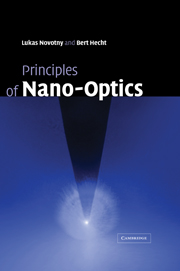Book contents
- Frontmatter
- Contents
- Preface
- 1 Introduction
- 2 Theoretical foundations
- 3 Propagation and focusing of optical fields
- 4 Spatial resolution and position accuracy
- 5 Nanoscale optical microscopy
- 6 Near-field optical probes
- 7 Probe–sample distance control
- 8 Light emission and optical interactions in nanoscale environments
- 9 Quantum emitters
- 10 Dipole emission near planar interfaces
- 11 Photonic crystals and resonators
- 12 Surface plasmons
- 13 Forces in confined fields
- 14 Fluctuation-induced interactions
- 15 Theoretical methods in nano-optics
- Appendix A Semianalytical derivation of the atomic polarizability
- Appendix B Spontaneous emission in the weak coupling regime
- Appendix C Fields of a dipole near a layered substrate
- Appendix D Far-field Green's functions
- Index
11 - Photonic crystals and resonators
Published online by Cambridge University Press: 05 June 2012
- Frontmatter
- Contents
- Preface
- 1 Introduction
- 2 Theoretical foundations
- 3 Propagation and focusing of optical fields
- 4 Spatial resolution and position accuracy
- 5 Nanoscale optical microscopy
- 6 Near-field optical probes
- 7 Probe–sample distance control
- 8 Light emission and optical interactions in nanoscale environments
- 9 Quantum emitters
- 10 Dipole emission near planar interfaces
- 11 Photonic crystals and resonators
- 12 Surface plasmons
- 13 Forces in confined fields
- 14 Fluctuation-induced interactions
- 15 Theoretical methods in nano-optics
- Appendix A Semianalytical derivation of the atomic polarizability
- Appendix B Spontaneous emission in the weak coupling regime
- Appendix C Fields of a dipole near a layered substrate
- Appendix D Far-field Green's functions
- Index
Summary
In recent years, artificial optical materials and structures have enabled the observation of various new optical effects and experiments. For example, photonic crystals are able to inhibit the propagation of certain light frequencies and provide the unique ability to guide light around very tight bends and along narrow channels. The high field strengths in optical microresonators lead to nonlinear optical effects that are important for future integrated optical networks. This chapter explains the basic underlying principles of these novel optical structures. For a more detailed overview the reader is referred to review articles and books listed in the references.
Photonic crystals
Photonic crystals are materials with a spatial periodicity in their dielectric constant. Under certain conditions, photonic crystals can create a photonic bandgap, i.e. a frequency window in which propagation of light through the crystal is inhibited. Light propagation in a photonic crystal is similar to the propagation of electrons and holes in a semiconductor. An electron passing through a semiconductor experiences a periodic potential due to the ordered atomic lattice. The interaction between the electron and the periodic potential results in the formation of energy bandgaps. It is not possible for the electron to pass through the crystal if its energy falls in the range of the bandgap. However, defects in the periodicity of the lattice can locally destroy the bandgap and give rise to interesting electronic properties.
- Type
- Chapter
- Information
- Principles of Nano-Optics , pp. 363 - 377Publisher: Cambridge University PressPrint publication year: 2006



